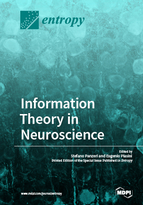Information Theory in Neuroscience
A special issue of Entropy (ISSN 1099-4300). This special issue belongs to the section "Information Theory, Probability and Statistics".
Deadline for manuscript submissions: closed (30 April 2018) | Viewed by 67376
Special Issue Editors
Interests: neural coding; information theory; population coding; temporal coding
Special Issues, Collections and Topics in MDPI journals
Interests: information processing in complex systems; neural coding; structure-function relationships in neural networks; normative models of neural function; perceptual decision-making; neuroinformatics
Special Issue Information
Dear Colleagues,
As the ultimate information processing device, the brain naturally lends itself to be studied with information theory. Application of information theory to neuroscience has spurred the development of principled theories of brain function, has led to advances in the study of consciousness, and to the development of analytical techniques to crack the neural code, that is to unveil the language used by neurons to encode and process information. In particular, advances in experimental techniques enabling precise recording and manipulation of neural activity on a large scale now enable for the first time the precise formulation and the quantitative test of hypotheses about how the brain encodes and transmits across areas the information used for specific functions.
This Special Issue emphasizes contributions on novel approaches in neuroscience using information theory, and on the development of new information theoretic results inspired by problems in neuroscience. Research work at the interface of neuroscience, Information Theory and other disciplines is also welcome.
Prof. Stefano Panzeri
Dr. Eugenio Piasini
Guest Editors
Manuscript Submission Information
Manuscripts should be submitted online at www.mdpi.com by registering and logging in to this website. Once you are registered, click here to go to the submission form. Manuscripts can be submitted until the deadline. All submissions that pass pre-check are peer-reviewed. Accepted papers will be published continuously in the journal (as soon as accepted) and will be listed together on the special issue website. Research articles, review articles as well as short communications are invited. For planned papers, a title and short abstract (about 100 words) can be sent to the Editorial Office for announcement on this website.
Submitted manuscripts should not have been published previously, nor be under consideration for publication elsewhere (except conference proceedings papers). All manuscripts are thoroughly refereed through a single-blind peer-review process. A guide for authors and other relevant information for submission of manuscripts is available on the Instructions for Authors page. Entropy is an international peer-reviewed open access monthly journal published by MDPI.
Please visit the Instructions for Authors page before submitting a manuscript. The Article Processing Charge (APC) for publication in this open access journal is 2600 CHF (Swiss Francs). Submitted papers should be well formatted and use good English. Authors may use MDPI's English editing service prior to publication or during author revisions.
Keywords
- population coding
- redundancy
- synergy
- optimal codes
- directed information
- integrated information theory
- neural decoders








